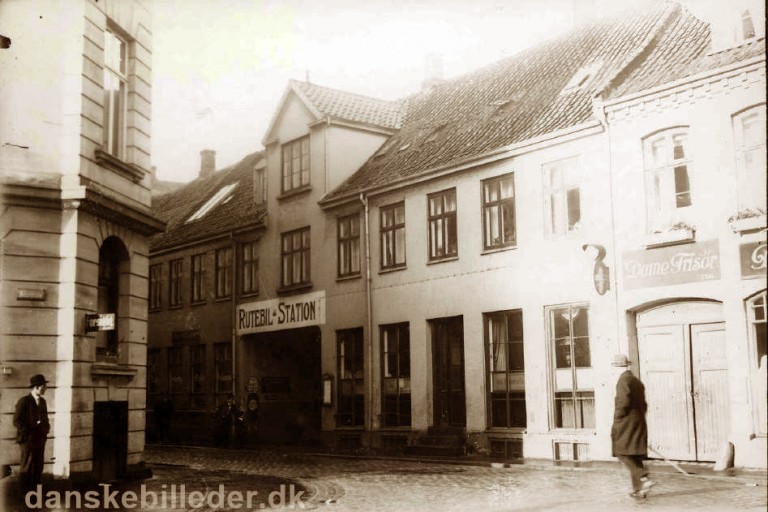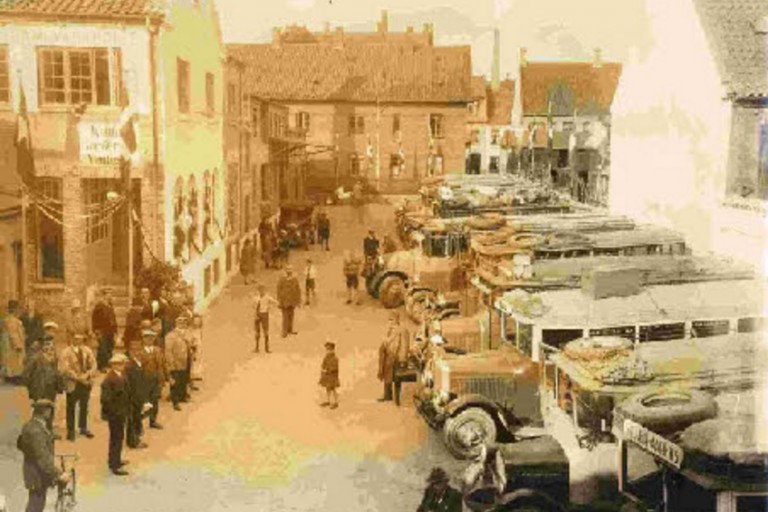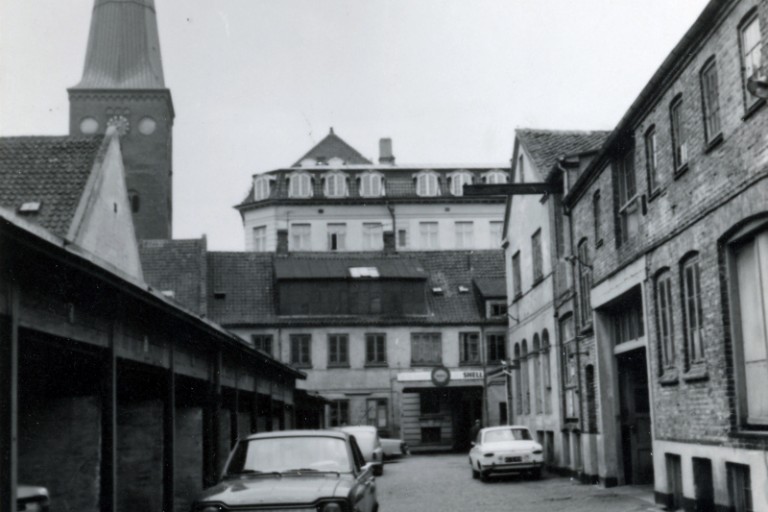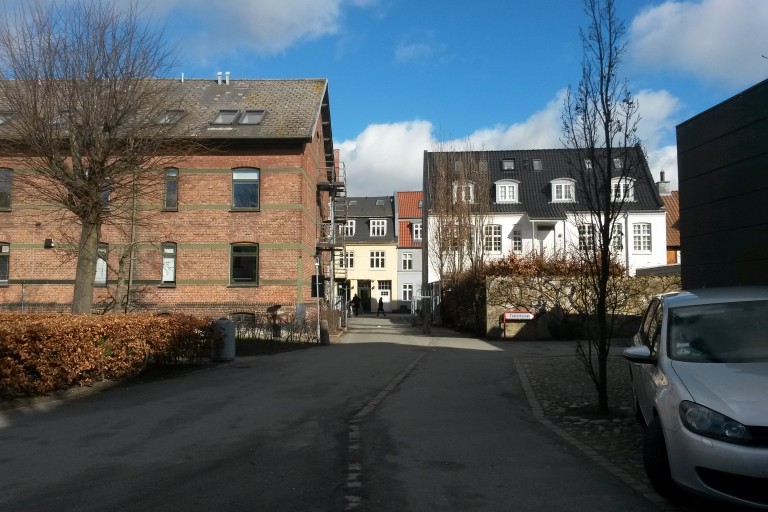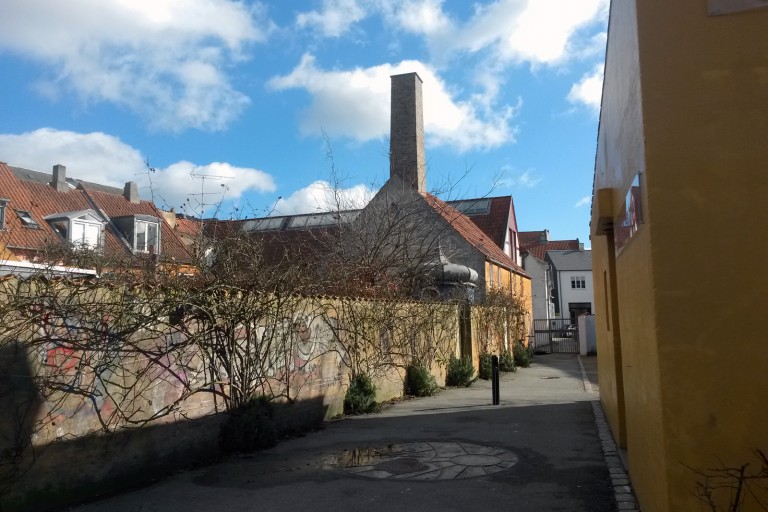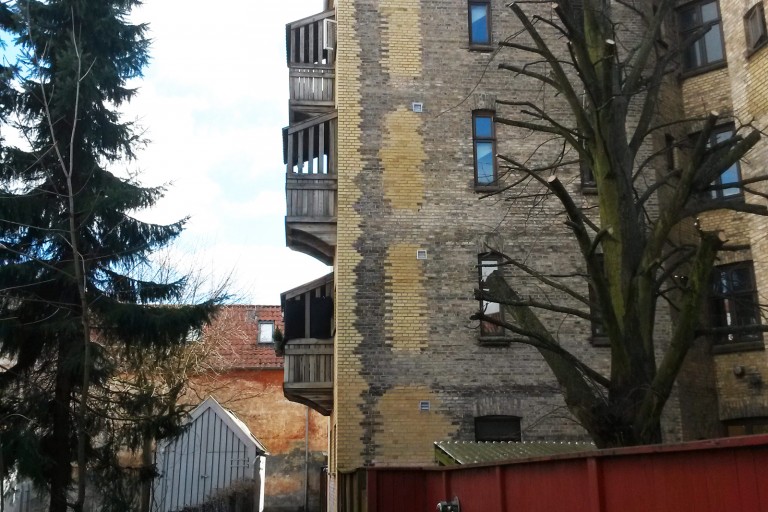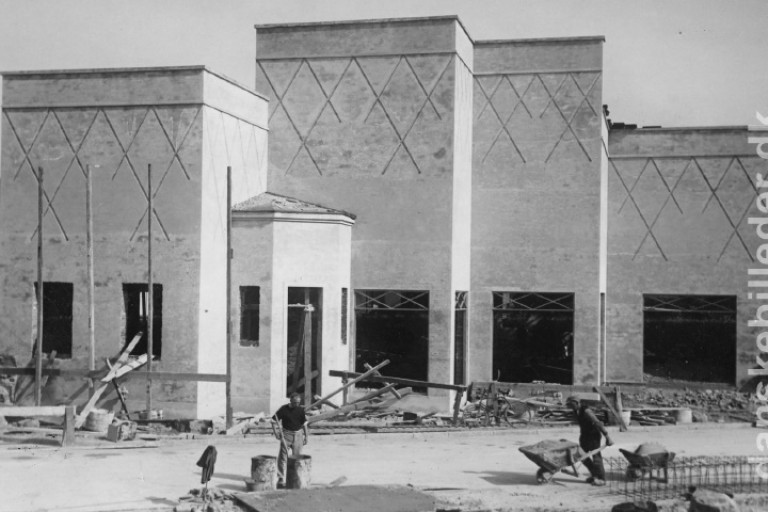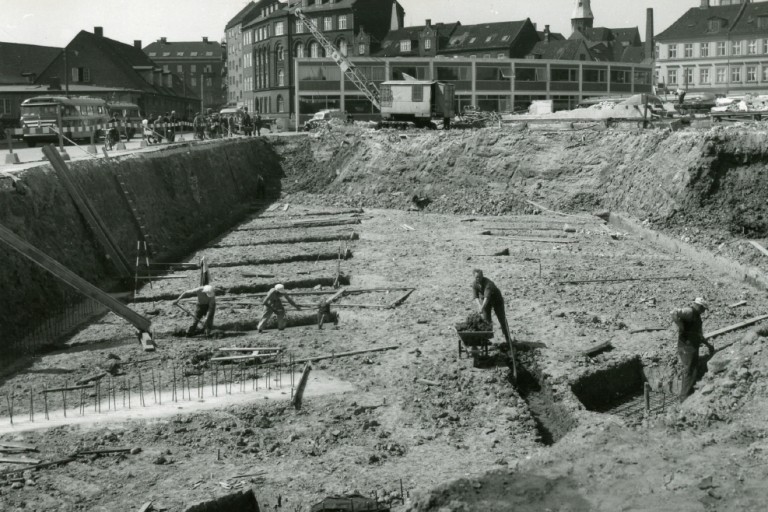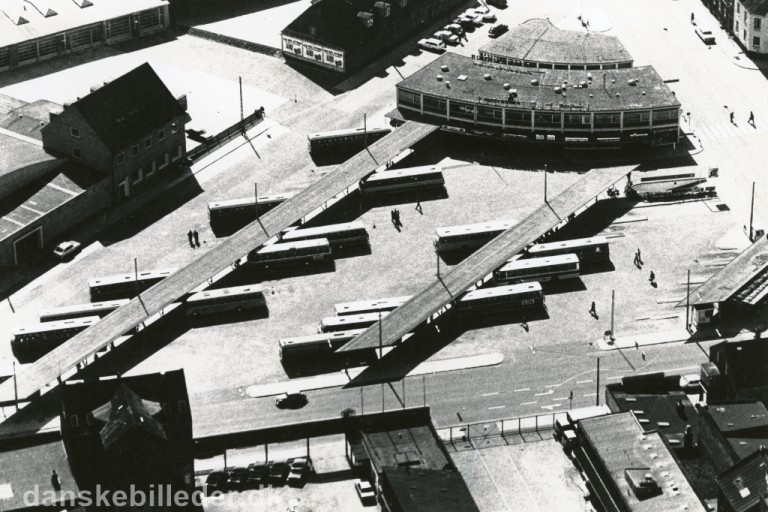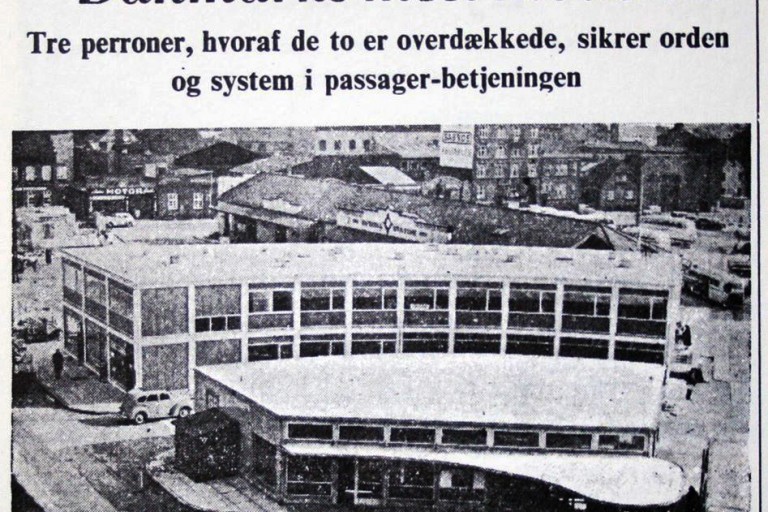BYENS IDENTITET OG FORANDRING/ CITY'S IDENTITY AND CHANGE
05-03-2017
Store byer fortættes
I fremtidens bysamfund forventes det, at vi kommer til at bo tættere. Folk flytter fra landet og ind til byerne samtidig med, at befolkningstallet forøges hurtigt. Det betyder, at byplanlægningen skal omstruktureres. Bebyggelserne bliver højere og tættere og samtidig hermed ændres infrastrukturen konstant. Hvad vi ser i dag, er måske væk i morgen. Gennem tiden forandres alt, men fysiske spor fra fortiden vil stadigvæk kunne findes her og der. Noget er synligt, mens andet er skjult, overdækket eller måske tildækket.
Big cities condenses
In the future urban society it is expected that we will live close to one another. People move from the countryside to the cities, while the human population is increasing rapidly. This means that urban planning should be restructured. The buildings are getting higher and closer and at the same time there will be constant change in infrastructure. What we see today are maybe gone tomorrow, but the physical traces of the past will still be available. Something is visible, while others are hidden or perhaps covered.
Aarhus Rutebilstation som eksempel
Den første rutebilsstation i Aarhus blev indretter i 1923 i Aarhus' gamle bymidte mellem Rosensgade 28 og Graven 19 - i det område, der i dag kaldes Teatertorvet. Området er tæt og snævert, da bydelen har sit fundament i vikingetiden og stadigvæk bærer præg af den snævre infrastruktur fra middelalderen
Rutebilerne stod tæt pakket og indkørslen fra porten i Rosensgade 28 var temmeli lille, hvilket også gjaldt udkørslen ved Graven. I takt med at behovet for buskørsel steg og de busserne fik ny design og kapacitet, blev rutebilstationen utidssvarende. Den gamle busstation blev derfor ombygget og indviet i 1927, men allerede i 1930 blev midtbyens rutebilstation for lille og svæver og en ny rutebilstation på tegnebrædtet.
Rutebilerne stod tæt pakket og indkørslen fra porten i Rosensgade 28 var temmeli lille, hvilket også gjaldt udkørslen ved Graven. I takt med at behovet for buskørsel steg og de busserne fik ny design og kapacitet, blev rutebilstationen utidssvarende. Den gamle busstation blev derfor ombygget og indviet i 1927, men allerede i 1930 blev midtbyens rutebilstation for lille og svæver og en ny rutebilstation på tegnebrædtet.
Aarhus Bus Station as an example
The first bus station in Aarhus was constructed in 1923 in Aarhus' old city center between Rosensgade 28 and Graven 19 - in an area that today is called the Teatertorvet (Theatre Square). The area is close and narrow, as the district has its foundation in Viking age and still bears signs of its narrow infrastructure from the Middle Ages.
The busses were tightly packed in the area and the driveway from Rosensgade 28 was quite narrow, as was the exit at the street Graven. As the need for increased bus driving and the buses themselves got new design and capacity, the bus station became outdated. The old bus station was therefore rebuilt and inaugurated in 1927, but already in 1930 the busstation in the City Center became rather compressed and a new bus station was under development.
The busses were tightly packed in the area and the driveway from Rosensgade 28 was quite narrow, as was the exit at the street Graven. As the need for increased bus driving and the buses themselves got new design and capacity, the bus station became outdated. The old bus station was therefore rebuilt and inaugurated in 1927, but already in 1930 the busstation in the City Center became rather compressed and a new bus station was under development.
Shell-gården
Efter Rutebilstationens udflytning overtog Hotel Royals Garageanlæg og Servicestation samt A/S Auto-Materiel den gamle busholdeplads. i den periode blev baggården kaldt Shellgården.
I Rutebilstationens venteværelse - en stor hvid bygning - oprettede grosserer H. Schrøn en agenturforretning med kolonialvarer, som det hed den gang. Bagved lå endvidere Hans Kjærs Sæbefabrik og Svendborg Eddikefabrikker.
I Rutebilstationens venteværelse - en stor hvid bygning - oprettede grosserer H. Schrøn en agenturforretning med kolonialvarer, som det hed den gang. Bagved lå endvidere Hans Kjærs Sæbefabrik og Svendborg Eddikefabrikker.
Shell-gården
After the Intercity bus station's relocation Hotel Royal's garage and Service Station as well as A / S Auto Equipment took over the place. In this period the area was called Shell-gården.
In the bus station's waiting room - a large white building - merchant H. Schrøn established an agency business with groceries. Behind those buildings Hans Kjaer's Soap Factory and Svendborg Vinegar Factories was placed.
In the bus station's waiting room - a large white building - merchant H. Schrøn established an agency business with groceries. Behind those buildings Hans Kjaer's Soap Factory and Svendborg Vinegar Factories was placed.
I perioden fra 1964 – 1980 blev fabrikker, forretning og garager revet ned lidt efter lidt, hvilket har resulteret i et åbent rum med en mindre parkeringsplads og en lille skjult, grøn oase bag parkeringspladsen, som kun de færreste bemærker. Området fremstår som et lille historisk åndehul med et gemt stisystem, der blandt andet omkrandser Vuggestuen Graven, men samtidig viser en del af den gamle bydels bagside.
Porten til den gamle Rutebilstation og senere Shellgården er idag lukket af et murværk. der skaber en lukket baggård. Indgangen til området således er rykket til naboporten, der fungerer som passage (Teaterpassagen), og samtidig gør stedet mere hemlighedsfyldt og overraskende.
Theatre Square (teatertorvet) and Teaterpassagen has its name from Rosenteatert, now located in the back yard.
Porten til den gamle Rutebilstation og senere Shellgården er idag lukket af et murværk. der skaber en lukket baggård. Indgangen til området således er rykket til naboporten, der fungerer som passage (Teaterpassagen), og samtidig gør stedet mere hemlighedsfyldt og overraskende.
Theatre Square (teatertorvet) and Teaterpassagen has its name from Rosenteatert, now located in the back yard.
In the period 1964 - 1980 both factories, business and garages was demolished little by little, which resulted in an open space area with a small parking lot and a small hidden green oasis, as only few people notice.The area appears as a small green and historic sanctuary bihind the parking lot with hidden paths that surround the Nursery house Graven, but also shows a part of the old town's back side.
The old gate to the Bus station and later Shell-gården is today closed by a brickwork that creates an enclosed courtyard. The entrance to the area thus moved to the neighboring gate which is smaller as a passage (Teaterpassagen), but at the same time makes the place more secret and surprising.
The old gate to the Bus station and later Shell-gården is today closed by a brickwork that creates an enclosed courtyard. The entrance to the area thus moved to the neighboring gate which is smaller as a passage (Teaterpassagen), but at the same time makes the place more secret and surprising.
Den nye rutebilstation
I 1872 købte Statsbanerne Amtmandstoften nær ved Hovedbanegården. I 1930 blev der, grundet en fordobling af antallet af ruter, opført en ny Rutebilstation på grunden. Den nye station var tegnet af arkitekt Wilhelm Klemann.
The new bus station
In 1872 the state railways bought "Amtmandstoften" near the main train station. In 1930 - due to a doubling of the number of routes - a new Bus station was built at the place. The new station was designed by architect Wilhelm Klemann.
Wilhelm Klemanns rutebilstation var et imponerende bygningsværk i nyklassicistisk stil med spor af art deco - eller skønvirke. Desværre fik han ikke nogen plads i arkitekturhistorien, og rutebilstationen, der var unik, synes derfor at være gået i glemmebogen. I Weilbacks kunsthistorie siges det, at hans bygninger var formet over samtidens byggestil, men uden det særpræg, som kunne have givet dem en plads i arkitekturhistorien. Dette gælder dog ikke rutebilstationen, der ud over at rumme et kompleks af funktioner også på daværende tidspunkt kaldtes Nordeuropas største rutebilstation.
Stationen havde ud over ventesal og garager også automobilværksted for busser og lastbiler, tankstation, café og kiosker. Stedet stod kun i 24 år.
Stationen havde ud over ventesal og garager også automobilværksted for busser og lastbiler, tankstation, café og kiosker. Stedet stod kun i 24 år.
Wilhelm Klemann's bus station was an impressive building in neoclassical style with hints of art deco - or nouveau. Unfortunately he got no place in the history of architecture, and the bus station that was unique, seems to have gone into oblivion. In Weilbacks art history it is said that his buildings were shaped the contemporary architectural style, but without the feature that could have given them a place in the history of architecture. This does not apply to the bus station, which in addition to house a complex of features also at that time was called Northern Europe's largest bus station.
thw complex included waiting room and garages as wellas repair shop for buses and trucks, petrol station, cafe and kiosks. The place was remaind only for 24 years.
thw complex included waiting room and garages as wellas repair shop for buses and trucks, petrol station, cafe and kiosks. The place was remaind only for 24 years.
Den tredje station
I 1954 blev pladsen i den indre gård for trang og utidssvarense. Den gamle station blev jævnet med jorden og tilbage er kun fotodokumentation og fortællingen. Den tredje station blev opført samme sted som et åbent anlæg med plads til 64 busser og i to etager - et underjordisk garageanlæg og den synlige overjordiske åbne plads.
The 3th station
In 1954, the space in the inner courtyard became too narrow and outdated. The old station was demolished and the only trace that remains is photo documentation and narrative. The third station was built the same place as an open system with space for 64 buses and build in two floors - one underground garage and the visible aboveground open space.
Når tiden går
I 63 år har stationen stået næsten uændret, men på et tidspunkt i forløbet er stationens underjordiske garageanlæg gået i glemmebogen. I dag fungerer den som udlejnings parkeringskælder for Europcar, men det ved kun de færreste. Kælderen hører til det man kan betegne som et skjult, forfaldent og skummelt sted, men også et sted, der rummer masser af fine detaljer fra fortiden som garage og biludlejning.
Stedets patina og forfald har tiltrukket kunstnere inden for både film- og musikbranchen, der har anvendt det som lokation for kortfilm og musikvideoer.
Så længe det varer - for intet varer evigt.
Stedets patina og forfald har tiltrukket kunstnere inden for både film- og musikbranchen, der har anvendt det som lokation for kortfilm og musikvideoer.
Så længe det varer - for intet varer evigt.
As time goes by
In 63 years the station has been almost unchanged, but at some point in the during time, the station's lower floor sunk into oblivion. Today it functions as rental car park for Europcar, but only known by very few. The basement belong to what might be described as a hidden, sinister and dilapidated place, but also a place that offers plenty of fine detail from the past as a garage and car rental.
The patina and decay has attracted artists in both the movie and music industry who have used the site as a location for short films and music videos.
As long as it lasts - for nothing lasts forever
The patina and decay has attracted artists in both the movie and music industry who have used the site as a location for short films and music videos.
As long as it lasts - for nothing lasts forever
I årene 1926 - 1954 oprettede DSB Postadministration, ilgodspakhus, autoværksted, signalværksted og rutebilgarage på en grund overfor på østsiden af rutebilstationen. Den storste af bygningerne er busgaragen, der blev bygget i 1954 og fungerede som sådan indtil ca. 2011, hvorefter den blev anvendt som bilparkeringshus.
Det har længe været planen at flytte rutebilstationen tættere på banegården, hvilket sandsynligvis også fører til nedlæggelse af funktionerne i centralværkstedernes område overfor rutebilstationen. Hvorom alt er har den gamle busgarage nu mistet sig oprindelige funktion, men grundet stedets fine potentiale for midlertidig brug for iværksættere åbnede et midlertidigt street food-marked i garagen i sommeren 2016. Aarhus Street-Food har ca. 30 gadekøkkener med mad og drikke med inspiration fra hele verden.
Det har længe været planen at flytte rutebilstationen tættere på banegården, hvilket sandsynligvis også fører til nedlæggelse af funktionerne i centralværkstedernes område overfor rutebilstationen. Hvorom alt er har den gamle busgarage nu mistet sig oprindelige funktion, men grundet stedets fine potentiale for midlertidig brug for iværksættere åbnede et midlertidigt street food-marked i garagen i sommeren 2016. Aarhus Street-Food har ca. 30 gadekøkkener med mad og drikke med inspiration fra hele verden.
In the years 1926 - 1954 created the railway administration created Post Administration, urgent consignments warehouse, workshop and signal busgarage on a plot opposite the east side of the bus station. The largest of the buildings are the bus garage which was built in 1954 and served as such until about 2011 after which it was used as a car parking garage.
It has long been the plan to move the bus station closer to the railway station, which also can lead to abandonment of the the workshop area opposite the bus station. However, the old busgarage has now lost the original function, but due to the place's potential for temporary use for entrepreneurs a new street food market opened in the garage in the summer of 2016. Aarhus Street-Food has approximately 30 street vendors with food and drink with inspiration from around the world.
It has long been the plan to move the bus station closer to the railway station, which also can lead to abandonment of the the workshop area opposite the bus station. However, the old busgarage has now lost the original function, but due to the place's potential for temporary use for entrepreneurs a new street food market opened in the garage in the summer of 2016. Aarhus Street-Food has approximately 30 street vendors with food and drink with inspiration from around the world.
